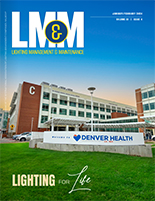National Lighting Bureau Reports Third-Quarter 2010 Lighting Systems Index Improvements
Silver Spring, MD: Third-quarter 2010 NEMA Lighting Systems Index (LSI) performance bested the second quarter’s by 0.9% and was 5.6% ahead of third-quarter 2009’s, the National Lighting Bureau (NLB) reports. “While it’s hardly cause for jubilation,” says NLB Executive Director John Bachner, “it should give rise to at least some guarded optimism.”
Established in 1998, NEMA’s LSI is a composite measure of lamps, luminaires, ballasts, emergency lighting, exit signs, and other lighting products shipped nationally and internationally from the United States by the 450 companies that comprise the National Electrical Manufacturers Association (NEMA). Adjusted for the season and inflation, the Index uses 2002 data for its 100-point benchmark. View it at www.nlb.org/Index/.
“The first quarter of 2010 was the third consecutive quarter of LSI growth, and it gave us reason to believe a sooner-rather-than-later turn-around was possible. That optimism was dashed when 2010’s second-quarter performance showed a 0.3% decline,” Bachner said.
“Right now it appears that the situation is holding steady; that any future declines are likely to be slight; and that improvements also will be sight, but they’re still likely to outnumber declines.”
The new residential- and commercial/industrial-construction markets are the principal drivers of lighting-equipment sales. Both are weak and will remain so through most of 2011. According to NEMA Director of Economic Analysis Brian Lego, “New housing starts have largely remained at depressed levels after bottoming out in late 2008. Foreclosures continue to mount and, barring any significant turnaround in the labor market, residential lamp demand will continue to struggle.”
Lego said much the same about the commercial/industrial market, noting that, while the steepest declines are over, “commercial and industrial construction activity in 2010’s third quarter continued a nine-quarter slide by contracting at an annualized rate of 20%.
Vacancy rates remain close to cyclical (and in some cases, record) highs and a substantial percentage of commercial and industrial loans are in default, forces that will certainly impede any upturn in nonresidential construction activity for several more quarters.”
Bachner commented that existing lighting-system upgrades will probably account for most commercial and industrial equipment sales in the near term. Indeed, while the thirdquarter LSI performance improvement can be attributed to growth scattered throughout the product groups tracked by the Index, fluorescent-ballast shipments registered the most appreciable increase, a development Bachner attributed to the July 1, 2010 phase-out of magnetic ballasts used for T12 fluorescent systems.
Established in 1976, the National Lighting Bureau is an independent, IRS-recognized not-for-profit, educational foundation that has served as a trusted lighting-information source since 1976. The Bureau is supported by the generous funding of its sponsors; professional societies, trade associations, manufacturers, and agencies of the U.S. government, including, among others:
• enLIGHTen America;
• GE Lighting;
• GonLED, LLC;
• Illuminating Engineering Society of North America (IES);
• Imperial Lighting Maintenance Company;
• interNational Association of Lighting Management Companies (NALMCO);
• Lighting Alternatives, Inc.;
• Lighting Controls Association;
• Lutron Electronics Company, Inc.;
• Magnaray;
• National Electrical Contractors Association (NECA);
• National Electrical Manufacturers Association (NEMA);
• OSRAM SYLVANIA; and
• U.S. General Services Administration.
For more information about the Bureau, visit www.nlb.org or contact Bureau staff: [email protected] or 301/587-9572. NEMA is a founding sponsor of the National Lighting Bureau and creator of the enLIGHTen America communications campaign (www.nemasavesenergy.org). NEMA members manufacture a wide range of products used in the generation, transmission, distribution, and control of electricity, as well as innumerable end-use products in addition to those used in lighting. Worldwide sales of NEMA members’ products exceed $120 billion.



